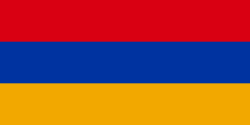Araks
| Araks / Aras Aras Nehri Արաքս Araz ارس (rud-e) Aras | |
|---|---|
 Araks på grænsen mellem Iran og Nakhitsjevan | |
| Overblik | |
| Land | |
| Løber igennem | Øst-Aserbajdsjan, Syunik Province |
| Geografi | |
| Udspring | |
- sted | ved Erzurum, Tyrkiet |
- højde | ca. 2.700 m.o.h. |
- koord. | 39°20′54″N 45°04′29″Ø / 39.34833°N 45.07472°Ø |
| Udmunding | Kura |
- koord. | 40°01′06″N 48°27′12″Ø / 40.01833°N 48.45333°Ø |
| Primær kilde | Erzurum |
| Bifloder | Fra højre: Zangmar, Sariso, Ghotur, Hadschilar, Kalibar, Ilghena, Darreh, Balha Fra venstre: Ghareso, Akhurjan, Metsamor, Hrazdan, Azat, Vedi, Arpa, Naxçıvançay, Vorotan, Voghdzji, Meghri |
| Fysiske kendetegn | |
| Længde | 1072[1] km |
| Afvandingsareal | 102.000[1] km² |
 | |
| Oversigtskort | |
| Information med symbolet | |
Araks eller Aras (persisk: ارس) er en stor flod i Kaukasus og Det armenske højland. Den er 1.072 km lang og har et afvandingsområde på på 102.000 km².
Udspringet ligger syd for Erzurum i Tyrkiet. Herfra løber den østover til grænsen til Armenien, hvor den drejer mod sydøst og først danner grænsen mellem Armenien og Tyrkiet. Så udgør den grænsen mellem den aserbajdsjanske enklave Nakhitjevan og Iran og derefter mellem Armenien og Iran. Derefter drejer Araks mod nordøst og danner grænsen mellem Iran og Aserbajdsjan. Ved İmişli løber den ind i Aserbajdsjan og munder til slut ud i Kura.
Araks er dæmmet op med Aras-dæmningen ved løbet i Nakhitjevan, hvor der i 1960'erne i Sovjettiden blev opført et vandkraftværk.
I antikken hed floden Araxes.
Kilder og henvisninger
|
Koordinater: 39°20′17″N 41°19′42″Ø / 39.33792°N 41.32823°Ø
Medier brugt på denne side
Flag of Iran. The tricolor flag was introduced in 1906, but after the Islamic Revolution of 1979 the Arabic words 'Allahu akbar' ('God is great'), written in the Kufic script of the Qur'an and repeated 22 times, were added to the red and green strips where they border the white central strip and in the middle is the emblem of Iran (which is a stylized Persian alphabet of the Arabic word Allah ("God")).
The official ISIRI standard (translation at FotW) gives two slightly different methods of construction for the flag: a compass-and-straightedge construction used for File:Flag of Iran (official).svg, and a "simplified" construction sheet with rational numbers used for this file.
Forfatter/Opretter: en:user:M karzarj, Licens: CC BY-SA 3.0
Aras river in the vicinity of Julfa-Iran (Left hand Iran - Right Hand Nakhichevan) - March 2006. The island seen in this picture is on the Iranian side of the border and is named Kasiri Island, after lieutenant Nourollah Kasiri. Kasiri was an Imperial Iranian Army cartographer who acted as Iran's representative in border dispute with the Soviet Union and persuaded the Soviets to accept this river island as Iranian by risking his own life.
Forfatter/Opretter: Bourrichon - fr:Bourrichon), Licens: CC BY-SA 4.0
Topographic map in French of Caucasus
Forfatter/Opretter: user:Shannon1, Licens: CC BY-SA 4.0
Varto's position has been corrected on the map.







